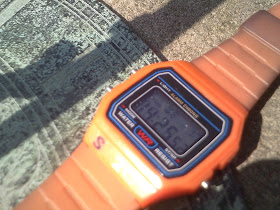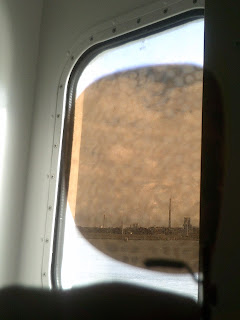Tuesday, 30 August 2016
Sundial at Chirk Castle
The sundial at Chirk Castle is in the beautiful rose garden. It is not adjusted for British Summer Time so read 1.13pm. So that's 22 minutes out. I don't think any of the correction curves I have seen are out by that much. I was thinking of taking a compass to check for south but that's no use because it would give magnetic south not the direction of the Sun when it is highest in the sky...
Monday, 29 August 2016
Sonnenuhr in Düsseldorf: Equation of time
Another great municipal sundial. Note that the angle of the gnomon is only 51 degrees because we are much further south. A correction curve has been provided. It explains that there is a discrepancy between Sun-time on a given day and what you ought to expect. In other words, it doesn't take exactly the expected 24 hours between noon on two consecutive days - ie the time when the Sun is highest in the sky. This is due to three considerations: 1. The orbit of the Sun is not a perfect circle and is a slight ellipse. 2. The axis of the Earth is tilted. 3. The Earth is not just rotating on the spot. Every day it goes on its orbit round the Sun a little bit further. I noticed that the correction curve given is different to the one I've seen before at Amble in Northumberland http://wigtonphysics.blogspot.co.uk/2014/08/time-in-amble.html So the correction must be location dependent. I have found this https://en.wikipedia.org/wiki/Equation_of_time which I hope to have time to understand soon.
Saturday, 27 August 2016
The Three Shires Stone - Nodes and Networks
The Three Shires Stone marks the place where Lancashire, Westmorland and Cumberland used to meet. On the map, three lines come together at a point. That looks like the way they draw networks. The point is a node and the more lines coming into it, the more important it is. In a recent edition of Physics World, there was a report on the use of network analysis to see if Icelandic sagas were history or fiction. Links were drawn between characters. The characters were the nodes and the more lines they got the more important they were. If it looks like real life networks, it could be history rather than fiction. I need to check this but I don't think you can have a node like the Three Shires Stone with only two counties meeting. The interface would be a line. An example would be Caithness and Sutherland.
Friday, 26 August 2016
Robot lawnmower
We visited a house with this robot lawn mower. It senses the edge and turns the mower. It seemed to work on a law of reflection principle so that it covered the grass but not in logical lines like a human would. It was likened to a browsing sheep. I'm not sure what it was sensing - is a hedge a good enough target?
Wednesday, 24 August 2016
Odd vapour trail
I saw this whilst washing up. The higher white vapour trail had a lower dirty equivalent. My first thought was that it was a shadow of the trail cast onto lower cloud. The angle of the |Sun seemed wrong for that and it does seem to continue between two of the lower clouds and continue on to the horizon. Maybe it's just a coincidence and there is no link. Human minds are programmed to see links.
Tuesday, 23 August 2016
Calibrating the step counter in Martindale
We have a new step counter. You have to tell it your step length so it can tell you how far you have gone. The problem with hills is that step length is so variable. I did over 31000 steps and it told me that I had done 22km. On the map we'd done 17km. We will need to keep tweaking the step length input until we get the right distance covered.
Monday, 22 August 2016
Monitoring the light level at Chirk Castle
This is Chirk Castle, just over the border into Wales. It is owned by the National Trust. I spotted the "Light Monitoring" on a piece of furniture in the first room. Photons of light can provide enough energy to change the chemicals in some materials over time and ruin them. This is a problem in preservation. So they put blue material into a card. The material you can see is exposed to the light but there is more under the cardboard that acts as a control. The difference between the two is read by a machine. Wonderfully simple and low-tech: Physics applied in conservation.
Sunday, 21 August 2016
Earthed electricity pylon
Having figured out that the top wire is the Earth wire, I was wondering how it was wired to the ground. Did it go through the metal framework? I found this example at Chester Services on the M56. If you look carefully at the point of the pylon, there is a junction taking the wire down. Then there are pegs down the left hand side that carry a wire down to the ground. There was the same on the far right.
Saturday, 20 August 2016
Tiny rainbow in Grasmere
This tiny rainbow caught our attention. Technically, rainbows are a full circle based around what is called the anti-solar point. You get to the anti-solar point by following a line from the Sun down through you and into the Earth beneath. Keep going until you are as far below ground as the Sun appears to be above ground. So in summer, when the Sun is higher in the sky, the anti-solar point will be deeper underground and the section of a rainbow visible above ground will be smaller. Even so, I was surprised by how small this was! It was only about 10am BST so if we had waited 3 hours until noon GMT then presumably it would have been even smaller! Thanks to Paul for taking the pictures.
Friday, 19 August 2016
More tensioning weights for railway cables
Spotted from the train on the way to Cologne. 13 discs. Say diameter 15 cm and depth 4cm. Volume would be about 700 cubic cm. A search suggested a density of 2.4 grams per cubic centimetre for hardened concrete. That means each block would be 1.7 kg. The total stack would be 22 kg. That would be a force of about 200N. Is that enough? I need to look at the size of the wires next time. I think the blocks are concrete. If they were steel, the force would be nearly 4 times bigger.
Wednesday, 17 August 2016
Light sensors on the street lights - first decent storm of the summer
We had the first big thunderstorm of the summer through Wigton at breakfast time a couple of weeks ago. The streetlights came on. They must be fitted with light sensors. These can't be simple Light Dependent Resistors because these use energy from photons to promote electrons from the valence band to the conduction band. More electrons in the conduction band means higher current so we say that the resistance is lower. (I think this is a bit of a cheat because it doesn't mean that the lattice ions are vibrating any less). So in the dark the resistance will be higher. Less current would not put the light on. So it must make use of electronics. A NOT gate would flip the input.
Tuesday, 16 August 2016
Two earths on the way to Utrecht
I was interested in this design of pylon in Holland. There are two top Earth wires - they carry no insulators. I wonder what the advantage is.
Sunday, 14 August 2016
No diffraction on Pike O'Blisco
An oddity on the summit of Pike O'Blisco was strong mobile phone signal on one end of the summit gully and no signal 5 metres away at the other end. The summit rocks might be 10 metres high. They seem to block the electromagnetic waves. Waves diffract around objects that are the same size as the wavelength. The average mobile phone wavelength in the UK is 30cm http://www.creative-science.org.uk/mobile_LED.html The summit rock is much bigger than this. The waves cannot diffract around them.
Saturday, 13 August 2016
Pool thermometer
I'm interested in how this pool thermometer works. I'd blithely assumed an electronic sensor. But it is a dial. That might actually be a coiled bimetallic strip. The idea there is that as the temperature rises, one metal expands more than the other and thus the strip uncoils. If a needle is attached to the coil, it goes round the scale.
Friday, 12 August 2016
Polarised windows in IJmuiden
I posted last month about polarisation patterns in train window glass. I wasn't sure how it was possible with only one polarising filter. On the ferry going into Amsterdam, I noticed that looking towards the Sun there was no polarisation pattern but looking at right angles to the Sun, there was a pattern (bottom photograph). That suggests that polarised light from the sky is acting as the first polarising filter.
Thursday, 11 August 2016
Green through the glass
These are two views of a glass television table. It was about 2cm thick and 75cm long. The top picture is looking down through the glass. You can hardly see it. There is a green strip along the top of the lower photograph. That is looking endways on into the glass. Glass contains some iron impurities. The iron ions absorb at the red and the blue ends of the spectrum so only the green gets through. It happens along the length because a lot of ions are needed to make the effect noticeable.
Wednesday, 10 August 2016
Organ pipe in Cologne Cathedral
Here's the organ loft at Cologne Cathedral. I estimate the length of the biggest pipe as 5 metres based on the height of the balcony rail. Assuming an organ pipe to be a closed end pipe, that represents 1/4 of a wavelength. Wavelength would be 20 metres. Frequency = speed/wavelength = 330/20 = 16.5Hz. Problem is that it would be below the frequency that humans can hear!
Tuesday, 9 August 2016
Inertia on the power lines: Neandertal
We were on the Autobahn crossing the Neandertal. I was interested that there were concrete blocks hanging below the insulators. I have not seen that in the UK. I am guessing that there are cross winds. The inertia of the mass makes the wind less likely to move the lines. There do not seem to be the metal hammer end rockers on the wires that are used in the UK.
Monday, 8 August 2016
Polarised views en route to Mönchengladbach
Here's the view of the Autobahn. In the top photograph, light from outside is transmitted through the windscreen. It hits the dashboard and is reflected upwards. The reflected light hits the windscreen. There is a partial reflection in my direction. The bottom photograph with a polarising filter shows no reflection, so that light reflected back from the windscreen must be polarised. The angle of reflection must have been above the Brewster angle. I think this is 57 degrees for glass. I thought it looked 45 degrees just sat in the car but perhaps I didn't look closely enough. For the record, I was in the passenger seat! I was a UK registered car...





































